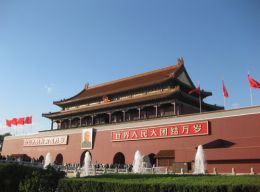Tian'anmen Gate-Tower
Tian'anmen (天安门) was the front gate of the Imperial City (Forbidden City). It was built in 1417, the 15th year of the reign period of Ming Emperor Yongle. It was formerly called Chengtianmen (the Gate for Receiving Heavenly Orders), and the name was changed to Tian'anmen in the early years of the Qing Dynasty.
Tian'anmen has an elevated red terrace with five arched gate openings. On top of the terrace is an imposing palace-like structure with nine bays, double-tiered eaves, and a xieshan (hip-and-garble) roof covered with yellow-glazed tiles. A white marble balustrade circumscribes the periphery of the structure.
In front of the gate are five Golden Water Bridges, which span a 52-m-wide moat. On the right and left sides of the bridges are two huge ornamental marble columns, called huabiao, decorated with carved dragons.
There was a corridor with red walls leading from Tian'anmen to Zhonghuamen on the south. Along the walls of the passage were small one-story buildings called "Corridor of 1,000 Steps." There were also two small gates on the east and west sides of the wall called the Left Chang'an Gate and Right Chang'an Gate, respectively, leading to Chang'an Avenue. In old times, these gates were guarded, and only officials above a certain rank were allowed to pass through.
In front of the Tian'anmen Gate is the Tian'anmen Square, which is 122 acres large. In the southern part stands the 38-meter high Monument to the People's Heroes and the Memorial Hall of Chairman Mao.
